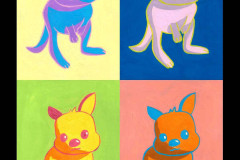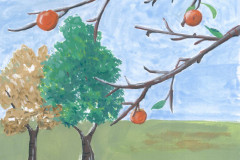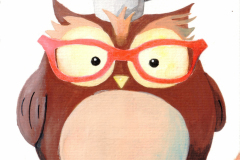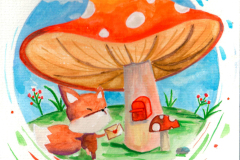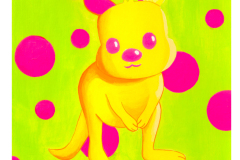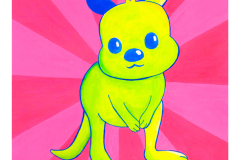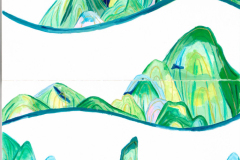Introduction
Gouache paint offers a unique way to power up your creative routine. Known for its opaque and vibrant qualities, this water-based medium blends qualities of watercolor and acrylic paint. It serves as a versatile tool that artists and creative individuals use to explore new textures and bold colors. By incorporating gouache into your daily practice, you can experiment with color layering, create striking contrasts, and apply quick drying techniques. These qualities make it suitable for both beginners and experienced artists aiming to push their boundaries.
Using gouache regularly can transform how you approach creative tasks. It helps break monotony by introducing a fresh and tactile aspect to your workflow. This paint type dries rapidly to a matte finish, granting you the ability to adjust and correct your work frequently. Whether you seek inspiration for illustration, poster design, or personal art projects, daily interaction with gouache can boost your imagination and develop new skills. Are you ready to build a creative habit that energizes your art and broadens your technique?
Understanding the Basics of Gouache Paint
Gouache paint is a water-based medium made from pigment, water, and a binding agent like gum arabic. Unlike watercolor, gouache contains more pigment and an inert white filler, which gives it its unique opacity. This means you can layer colors without the lower layers showing through, allowing for solid, vibrant coverage.
Gouache dries to a matte finish, making it different from the translucent look of watercolor and the glossy surface of acrylic. It can be re-wet and reworked even after drying, giving you flexibility during your painting process. Artists often choose gouache because it combines bright colors with the ease of water cleanup.
Historically, gouache has served both traditional painters and commercial artists. It has been favored in fine art for portrait and landscape work while also appearing in poster art and book illustrations. Using gouache daily can help you experiment with color layering and detail without waiting long for your paint to dry. How might incorporating gouache change your approach to creating art?
Key Characteristics of Gouache
The main trait of gouache is its opacity. When you paint with it, each stroke covers what’s beneath completely. This allows you to fix mistakes or add bright highlights easily. The drying time is usually quick but slower than acrylic, giving you more time to blend and adjust your work.
Gouache dries with a matte finish, which means your art will appear flat and free of shine. This surface reduces glare and makes your colors look rich and smooth in photos or prints. The pigment concentration is higher than in watercolor, so your colors stay intense even when diluted.
These properties affect how you build your painting. You can start with dark colors and add lighter ones on top, unlike watercolors where light layers come first. This reversibility opens new ways to create depth and detail. Have you tried layering light over dark in your paintings before?
Historical Context and Usage
Gouache has roots dating back over a thousand years, used first by Persian and medieval European artists. It gained popularity in the 18th and 19th centuries when it became a favored medium for illustrations and decorative painting. Artists valued its quick drying time and vibrant finish.
Commercial art embraced gouache in the 20th century, especially in posters, comics, and animation cells. Studios used gouache to make bold, flat colors that printed clearly. Today, it remains a staple for illustrators and designers who need precise control and durability in their work.
Using gouache connects you to a long tradition of artists who balanced fine art with commercial needs. What parts of this history inspire you to try gouache in your own projects?
Setting Up Your Workspace for Daily Gouache Painting
Creating a space that supports your daily gouache painting can change how often and how deeply you engage with your art. A well-arranged workspace reduces friction and keeps your focus on painting.
Consider having a dedicated table or desk with enough room for your supplies and a comfortable chair. Natural light helps you see colors more clearly, but if that’s limited, invest in a daylight-balanced lamp to avoid color distortion.
Keep your materials within easy reach. Use containers or small shelves to store paints, brushes, and cleaning tools. This saves time and discourages clutter buildup. Think about where spills might happen and protect surfaces accordingly.
Arrange your area so you can move freely. Avoid placing distractions like phones or unrelated objects nearby. Does your setup invite you to pick up your brush every day? If not, try repositioning or adding elements that spark inspiration.
Essential Materials Needed
Selecting the right materials supports consistent gouache practice. Start with a small set of quality gouache paints. Brands like M. Graham and Winsor & Newton offer good options at different price points. You don’t need every color at first; focus on the basics and expand over time.
Choose brushes designed for gouache, such as synthetic or sable blends that hold water well and maintain form. Look for sizes ranging from small detail brushes to medium flats for washes.
Paper choice affects your results. Heavier watercolor paper or mixed-media paper around 140 lb (300 gsm) handles gouache better than thin sketchbook pages. Try both textured and smooth surfaces to see what suits your style.
Use a palette with multiple wells for mixing. Plastic or ceramic palettes work fine. Have a jar of water and paper towels nearby to keep brushes clean and adjust paint consistency.
Organizing Your Creative Space
Arrange your workspace to encourage steady creative flow and limit interruptions. Position your easel or table close to a light source. If possible, face your window or set your lamp at an angle to reduce glare.
Store your materials in containers you can label or sort by type. Keep fresh water separate from cleaning water to avoid muddy colors. A rolling cart or stackable drawers can hold supplies without crowding your main area.
Pay attention to ergonomics. A chair with back support and a table at a comfortable height will keep you painting longer without strain. Think about how you sit and reach your paints.
Would changing your surroundings improve your daily habit? Even small tweaks like opening a curtain or adding a plant can make your workspace more inviting and boost your commitment to painting each day.
Techniques to Master When Using Gouache
Fundamental Gouache Methods
Applying gouache in layers allows you to build color intensity and correct mistakes without losing brightness. Start with thin washes, letting each layer dry before adding another. This practice helps control your painting’s depth and avoids muddy colors.
Gradients form by blending wet colors side by side or by glazing thin layers once dry. Timing is key here. If you blend too late, edges harden; too soon, colors mix completely. Testing drying times for your specific paint helps you find that balance.
You will notice that gouache dries quickly. Working fast improves flow but demands planning. Keeping a spray bottle nearby can reactivate paint and extend blending time. Managing drying times builds your confidence and smooths daily painting sessions.
Creative Experimentation with Texture
Brush strokes shape the feel of your painting. Try switching brushes—flat, round, fan—or apply paint with the handle, dabbing instead of stroking. What happens when you layer dry brush strokes over wet underlayers? Experiment and record results.
Mixing gouache with other mediums like watercolor or acrylic ink can produce new effects. Test these mixtures on scrap paper to see how texture and opacity change before using them in your work.
Tools like sponges or palette knives offer texture beyond brushes. Use a sponge to achieve soft blotches or a palette knife for raised, sharp streaks. How might adding these textures change your daily paintings? Explore these techniques to refresh your routine and keep ideas flowing.
Incorporating Gouache into Your Creative Routine
Integrating gouache painting into your daily schedule requires clear planning and small, manageable steps. Start by selecting a specific time each day for painting, even if it is only 10 to 15 minutes. Consistency builds momentum and turns this activity into a habit rather than a chore. Try to keep your painting space ready and accessible so you can easily pick up your materials when the time comes.
Set clear and simple goals for each session, such as experimenting with a new color mix or working on a small section of a larger piece. Breaking down projects into achievable tasks prevents feeling overwhelmed and keeps you engaged. Use a timer to stay focused during these brief sessions, making your practice purposeful.
Ask yourself what you want to improve and how each session can help you get closer. Balancing dedicated art time with your other daily duties strengthens your skills and keeps your creative energy flowing. Are there moments in your day where a quick painting break would fit naturally? Identifying these moments helps weave gouache painting into your routine seamlessly.
Building Daily Painting Habits
Consistency matters for creativity. Schedule a short painting session at the same time every day to build routine. You might paint right after breakfast or before bed. Keeping sessions between 10 and 20 minutes makes painting feel doable and not like a burden.
Choose projects that match your time frame. Small studies, color tests, or simple shapes can provide quick wins. These manageable projects reduce the pressure to produce perfect work and encourage experimentation. When you complete these smaller tasks, you create a sense of achievement that motivates you to continue.
Organize your materials in one place. When your gouache, brushes, and paper are easy to reach, you eliminate barriers to starting. Have you tried creating a dedicated painting corner? This visual prompt can help remind you to paint daily and support habit formation.
Goal-Setting and Tracking Progress
Define realistic objectives to stay focused. Instead of aiming to finish a large painting each week, commit to daily skills practice or completing one study per session. Clear goals help you measure progress without feeling overwhelmed.
Keep a journal or folder of your daily paintings. Review your work weekly to track improvements and notice patterns in your style or technique. Seeing your development can boost confidence and motivate you to keep going.
Set questions to assess your progress. Are your color mixes becoming more precise? Has your brush control improved? Reflecting on your work gives direction and purpose to your practice. What achievements will you celebrate this week?
Drawing Inspiration from Gouache Art Examples
Many artists have used gouache to create striking works that offer great ideas for your own projects. Taking a close look at these pieces can help you rethink your approach and challenge your creativity. Observe how artists play with opacity, bold colors, and layered shapes to add depth and interest.
When you study influential gouache art, ask yourself which elements draw your attention. Is it the color palette? The brushstrokes? Or the way layers interact? Reflecting on these details allows you to bring fresh ideas to your practice and encourages experimentation beyond familiar styles.
Think about how your emotions or daily experiences connect with these works. How can you adapt their techniques to reflect your story without imitating? Use these examples as starting points to push your boundaries and build confidence in your unique voice.
Famous Gouache Artists and Their Work
Henri Matisse is a key figure when studying gouache. He used the medium to create vibrant, flat shapes and bold compositions that emphasized color and form. His cut-outs and gouache paintings show how simplicity can create strong visual impact.
Another artist to consider is Paul Klee, who applied gouache with playful lines and geometric shapes. Klee’s work highlights how using gouache for detail and texture brings life to abstract ideas. Comparing their styles reveals how different techniques achieve unique effects.
Look at how these artists balance spontaneity and control. How do they handle layering and color mixing? Noticing their brush treatment and composition strategies can provide concrete lessons to improve your daily gouache practice.
Applying Inspiration to Your Art
Start by identifying one technique from your favorite gouache artwork to experiment with. It could be layering opaque colors like Matisse or creating rhythmic patterns like Klee. Use this focus to guide a simple project, such as a small painting or study.
Keep your goal clear: to learn, not copy. Adjust the chosen technique to suit your style and subject. For example, swap colors or shapes to reflect your mood or setting. This way, you build skills while keeping your work original.
Ask yourself how these adaptations influence your creative thinking. Do they encourage you to try bolder choices or new compositions? Let your curiosity lead daily experiments that keep your routine fresh and meaningful.
Mixing Colors and Creating Palettes with Gouache
Gouache offers unique possibilities for mixing colors because of its opaque and matte finish. When you mix gouache, the paint’s thickness and opacity create colors that look different wet and dry. You need to learn how paint layers and opacity combine to get accurate hues.
Start with small amounts on your palette, mixing evenly to avoid uneven spots. Test your mixtures on scrap paper before applying to your artwork. This helps you see how the colors will appear once dry. Experiment by adding white or black to adjust tints and shades without losing coverage.
Creating palettes that serve your style is crucial. Limit your colors to a few that work well together and regenerate new tones by mixing. This approach keeps your painting process efficient and inspires new color ideas. Ask yourself what moods or themes your palette should support. Are you aiming for bold contrasts or soft gradients?
Keep a visual record of your mixes. Swatches with color notes help recreate favorite blends faster. Your daily practice can grow by exploring combinations and seeing how they change on paper. Mixing and palette creation aren’t just technical steps; they shape your creative flow.
Color Mixing Basics for Gouache
Primary colors in gouache are red, blue, and yellow. Mixing these gives you secondary colors like green, orange, and purple. For example, combine blue and yellow to get green. Adjust the balance to find your preferred shade.
The opacity of gouache affects mixing. Since gouache is opaque, it covers layers well, but mixing colors can dull brightness if you add too much of one hue or black. Try mixing pure colors before adding white or black. White lightens colors and can reduce saturation, so use it carefully.
Mix small amounts and test frequently. Sometimes tertiary colors—made by mixing primary and secondary hues—introduce new depth to your work. You might mix red-orange or blue-green by blending three colors. This practice helps you tailor colors precisely.
Think about how the paint dries. Colors usually dry a shade lighter. Does this affect how you mix colors at the start? Testing swatches daily trains your eye to anticipate drying changes and improves your color accuracy.
Developing a Personalized Palette
Your palette reflects your artistic goals and style. Start by choosing a few core colors that match your preferred themes. For example, if you enjoy landscapes, earthy greens and browns might be essential. If you paint portraits, focus on skin tones and complementary shades.
Limit your palette initially to avoid overwhelming choices. Use mixing to create variety within your small selection. This approach encourages deeper understanding of color relationships and avoids decision fatigue while painting.
Consider how you want your palette to support your daily routine. Do you need quick, flexible color options for fast ideas or precise shades for detailed work? Customize your palette around this question. You might swap colors weekly to keep your practice fresh.
Reflect on color temperature and harmony. Warm colors bring energy, while cool colors calm your work. Mixing these deliberately builds mood. What mood do you want your daily gouache paintings to convey? Your palette choices help achieve that.
Overcoming Common Gouache Painting Challenges
Using gouache paint every day comes with challenges that may affect your creative flow. One common hurdle is the shift in color once the paint dries. You might notice a hue appearing lighter or darker than expected, which can throw off your entire piece. Also, fixing mistakes without leaving marks on the surface requires skill. You want to correct errors while keeping the paper or board intact.
To handle these issues, you need practical methods. When colors dry differently, anticipating the change helps maintain consistency. For mistakes, knowing how to re-wet and carefully layer paint prevents damaging your work. Do you often stop mid-project because the colors seem off or because you accidentally smeared paint? Learning simple fixes can keep your momentum going and help you grow as a gouache artist.
Managing Color Changes When Dry
Gouache dries faster and loses moisture, causing colors to look different from when wet. They usually appear lighter or less vibrant. Understanding this shift is key to planning your palette. Try mixing colors slightly darker than your intended dry hue to match your vision.
Testing small patches before painting large areas helps predict outcomes. You can take notes on specific color reactions, which guides you on future projects. Certain brands or pigment mixes shift more noticeably, so knowing your materials is useful. How often do you test paint before committing? Simple experiments can save frustration and improve accuracy.
Correcting Mistakes Without Damage
When you spot a mistake, your first move should be to re-wet the area gently using a damp brush. This softens the paint, allowing you to lift or blend errors without roughing the paper. You don’t want to scrub hard because this can tear the surface.
If re-wetting does not fully fix the issue, layering a new paint layer after the first dries works well. Use thin, controlled strokes to avoid bulky buildup. When repainting, wait for the layer to dry before adding more paint to keep edges clean. Have you tried using a clean brush to smooth edges after fixing? Small touches like these keep your work smooth and polished without damage.
Using Gouache Beyond Traditional Painting
Gouache is not limited to canvas or paper artwork. You can use it in many creative ways to expand your artistic routine and produce fresh results. Combining gouache with other materials offers new textures and effects that invigorate your projects.
Try mixing gouache with ink to create sharp details over soft, matte paint layers. Adding collage elements like torn paper or fabric can introduce depth and complexity to your work. You can also paint gouache pieces, scan them, and bring those textures into digital design programs for further editing or layering.
Think about how this variety could spark your creativity. How might mixing physical and digital tools challenge your usual process? Could blending mediums help you solve artistic blocks? These questions invite you to rethink how you apply gouache and push your creative boundaries.
Exploring Mixed Media Compositions
Pairing gouache with ink pens allows you to outline shapes or add delicate details that stand out against the paint’s matte finish. Using collage materials like magazine cuts, textured paper, or natural elements combined with gouache shapes builds rich visual stories in your pieces.
Once you create these mixed media layers, photographing or scanning your work allows you to add digital adjustments. You might alter colors, add text, or incorporate graphics. This method opens more creative doors and helps build unique art portfolios.
Ask yourself if you’ve tried layering contrasting materials recently. Could integrating digital tools make your art more versatile? Experiment with blending traditional paint, collage, and digital design for surprising outcomes.
Gouache for Functional and Decorative Art
Gouache’s vibrant color and quick drying time make it ideal for creating posters, greeting cards, or invitations. You can design bold shapes or hand-lettered text with a fresh, handcrafted feel.
Decorate textiles with gouache by painting simple patterns on fabric items like tote bags or pillowcases. Sealing your work afterward helps maintain the paint’s vibrancy and durability. You might also paint on ceramics or wooden surfaces for personalized decorative objects.
How could applying gouache to functional items change your approach to daily creativity? Could making art that serves a purpose inspire you to create more often? Using gouache beyond paper adds a practical dimension to your artistic practice and gives everyday objects a unique touch.
Conclusions
Daily engagement with gouache paint enriches your creative routine by encouraging experimentation with colors and textures. It allows you to explore the physical qualities of paint such as opacity and quick drying, which support efficient and bold artistic decisions. Adopting gouache as part of your daily practice improves your skill set and fosters a hands-on approach to creativity, making your work more engaging and versatile.
Your creative process benefits from integrating gouache through increased flexibility and fresh inspiration. This medium can act as a reliable companion that challenges you to adapt and innovate while building confidence in color mixing and layering techniques. How will you use gouache to push your creative limits today and maintain a vibrant artistic routine tomorrow?


















